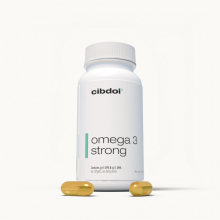What Are the Symptoms of Omega-3 Deficiency?
Published:
Omega-3 fatty acids provide wide-ranging health benefits, from supporting heart and brain health to reducing inflammation. These essential fats must come from the diet since the body can't make them. Not getting enough omega-3s over time can lead to deficiency and negative impacts on health and wellbeing. This article explores common symptoms and signs that may indicate an omega-3 deficiency.
Contents:

Overview of Omega-3 Fatty Acids
Omega-3s are polyunsaturated essential fatty acids that are crucial for the body and brain. There are three main types:
- ALA (Alpha-Linolenic Acid) - found in plants and can convert into EPA and DHA
- EPA (Eicosapentaenoic Acid) - promotes heart health and reduces inflammation
- DHA (Docosahexaenoic Acid) - critical for brain function and retina health
Experts suggest adults consume at least 250–500 mg per day of the omega-3s EPA and DHA for optimal health, but average intakes are often much lower.
While plant foods contain ALA, the most potent anti-inflammatory sources of EPA and DHA are fatty fish and fish oil supplements. Consuming enough of these omega-3s is vital to avoid deficiency.
Potential Causes of Omega-3 Deficiency
There are several potential reasons someone may become deficient in omega-3s:
- Eating a diet very low in fatty fish and seafood
- Not eating many ALA-rich plant foods like walnuts, flax and chia
- Following a vegan or vegetarian diet without ALA supplements
- Having malabsorption issues that inhibit fat digestion and uptake
- Taking medications that impair nutrient absorption like oral steroids
- Carrying genetic mutations affecting enzyme conversion of ALA to EPA/DHA
Groups at higher risk of omega-3 deficiency include vegetarians, vegans, the elderly, and those with digestive disorders like celiac or Crohn’s disease.
Symptoms and Signs of Omega-3 Deficiency
Possible symptoms and signs that may indicate an omega-3 deficient state include:
Cognitive Decline
- Poor memory
- Trouble learning and concentrating
- Brain fog
DHA makes up a substantial portion of the brain’s structure. Deficiency negatively affects cognition.
Vision Changes
- Blurred vision
- Dry eyes
- Eye fatigue
DHA is concentrated in the retina. Low levels may cause visual problems.
Skin, Hair & Nail Issues
- Dry, flaky skin
- Scaly rashes
- Soft, brittle nails
- Dry, brittle hair
Omega-3s keep cell membranes flexible. Deficiency leads to poor skin, nail and hair texture.
Mood Issues
- Depression
- Irritability
- Anxiety
Omega-3s regulate neurotransmitters and hormones that control mood and stress response.
Poor Immunity
- Frequent colds/flu
- Taking longer to recover when sick
- Recurring infections
Omega-3s reduce inflammatory cytokines. Deficiency may diminish immune response.
Fatigue
- Low energy levels
- Feeling tired despite adequate sleep
Omega-3s support mitochondrial function. Deficiency can cause fatigue.
Poor Circulation
- Numbness or tingling in hands and feet
- Feeling cold easily
- Reduced exercise performance
Omega-3s promote blood flow. Lack of omega-3s may impair circulation.
Diagnosing Omega-3 Deficiency
Omega-3 deficiency is not commonly screened for with standard lab tests. However, some specialty labs can measure levels of EPA and DHA in red blood cells. This allows definitive diagnosis compared to reference ranges.
Your doctor may also order general fat blood tests that provide clues about omega-3 status based on high triglycerides, low HDL, and elevated inflammatory markers that would be expected with omega-3 insufficiency.
Paying attention to potential symptoms of deficiency coupled with dietary intake helps identify if low omega-3 status could be an issue.
Reversing Omega-3 Deficiency
The good news is that omega-3 deficiency can be reversed quickly with diet and supplement modifications:
Eat More Omega-3 Foods
- Fatty fish like salmon, sardines, mackerel 2–3 times per week
- ALA-rich foods like walnuts, flaxseeds, chia seeds daily
- Seafood like oysters and mussels weekly
- Enriched eggs and milks that contain EPA/DHA
Take an Omega-3 Supplement
- High-quality fish, krill, or algal oil
- Minimum 500 mg EPA/DHA daily
- Up to 2000 mg for heart health benefits
Cook with Omega-3 Oils
- Flaxseed oil
- Walnut oil
- Canola oil
Incorporating more omega-3-rich foods and oils quickly helps replenish EPA and DHA levels to resolve deficiency.
Food Sources of Omega-3s
To maintain optimal omega-3 status, include these foods regularly:
ALA Plant Sources
- Flaxseeds: 6,388 mg per 100 grams
- Chia seeds: 4,915 mg per 100 grams
- Walnuts: 2,574 mg per 100 grams
- Soybeans: 1,241 mg per 100 grams
- Navy beans: 237 mg per 100 grams
- Kidney beans: 406 mg per 100 grams
EPA/DHA Seafood Sources
- Salmon: 4,123 mg per 100 grams
- Sardines: 2,205 mg per 100 grams
- Anchovies: 951 mg per 100 grams
- Rainbow trout: 983 mg per 100 grams
- Atlantic mackerel: 1,699 mg per 100 grams
- Caviar: 1,086 mg per 100 grams
Combine both plant and seafood sources to ensure adequate intake of all omega-3s.
Key Takeaways on Omega-3 Deficiency Symptoms
- Potential symptoms of low omega-3s include brain fog, fatigue, poor immunity, mood issues, circulation problems and skin/hair changes.
- Groups at higher risk are those with low seafood intake, malabsorption disorders, or vegetarians/vegans.
- Increasing omega-3 rich fatty fish, plant foods, oils and supplements can resolve deficiency.
- Aim for at least 2 servings of fatty fish per week along with daily intake of plant sources like walnuts and flax.
- Symptoms coupled with low omega-3 intake may indicate deficiency worth correcting through diet and supplements.
Getting enough EPA, DHA and ALA from seafood, plant sources and supplements ensures optimal omega-3 status to feel your best and reduce deficiency-related risks.










